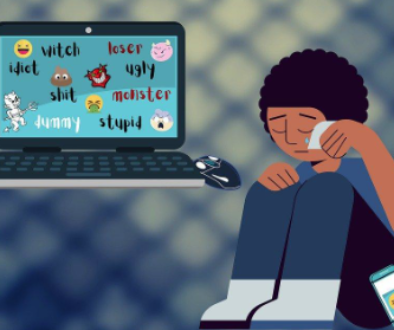What is Cyberbullying and How to Stop it?

Here are some latest statistics about cyberbullying that should frighten you:
- 37% of young individuals in the age group of 12-17 years have been subjected to online bullying. 30% of them have experienced bullying more than once.
- 23% of students have admitted saying something “mean” or “cruel” to another online person.
- 42% of young adults have experienced cyberbullying on the Instagram social media platform.
- 15% of teenage girls have been the target of abusive behavior – as compared to just 6% among boys.
From the above statistics, it is evident that growing teenagers are mostly targeted for cyberbullying (or online abuse). What makes this problem worse is that just 1 in 10 victims inform their parents or a trusted adult of their bullying experience.
What is cyberbullying and how can you stop it? Let’s discuss this in this article.
What is Cyberbullying?
Cyberbullying is the use of digital devices to bully another individual. UNICEF defines cyberbullying as “bullying with the use of digital technologies.” Typically, cyberbullying occurs on social media platforms, instant messaging tools, and online gaming platforms.
What actions constitute cyberbullying? Here are some common examples of cyberbullying:
- Sharing personal (or private) information of another person, thus causes embarrassment and humiliation.
- Sending abusive and hurtful messages directly to the individual.
- Impersonating another person and sending negative messages to others on their behalf.
- Sharing or posting shameful photos or videos of others on social media platforms.
Can parents or concerned adults stop cyberbullying? Next, let’s look at some measures to prevent or deal with cyberbullying.
How to stop cyberbullying
For young individuals, cyberbullying can be harmful as it leaves them scared, shamed, or hurt for a long period. Often, victims of cyberbullying blame themselves for the entire experience. 35% of cyberbullying victims have reported extreme levels of stress.
As parents or concerned guardians, you cannot completely protect your child from cyberbullies. However, you can take measures to reduce the impact of cyberbullying on your growing child. Here are some of the measures:
- Establish a bond of trust with your child.
Through constant communication, you can build a bond of trust and confidence with your child. Encourage your teenager to share their daily experiences in school. Children with healthy family support are more likely to share their online experiences.
If they do experience cyberbullying, do not react by blaming them for their ordeal. Be supportive by finding out how long they have been bullied – and try to discuss possible solutions.
- Use privacy settings.
Most social media platforms like Snapchat, Instagram, and TikTok offer privacy settings. This makes it difficult for other online users from tagging your child on shared photos – and requires your permission to share photos. You can either configure privacy settings on their mobile apps yourself – or help them with these settings.
- Teach them about personal stuff.
As a preventive measure, you should always discuss online risks with your children. Highlight the importance of not sharing their personal information like mobile number, home address, or email address on social media pages.
In this digital age, your child may have many online followers or friends, whom they haven’t met personally. Tell your child about the risks of online “impersonators” who claim to be someone else.
- How to respond to cyberbullying.
As parents, you must tell your children to not ignore or respond to online threats or negative messages. Instead of deleting these messages, encourage your child to report them along with any information about the cyberbully.
Additionally, your children can take the following measures to stop cyberbullying:
- Do not respond to any emails, messages, or comments posted by cyber bullies.
- Do not forward any shared image or video (sent by cyberbullies) to other children or post them on social media platforms.
- Report any cyberbullying incident to parents or school authorities.
- Save the screenshot of cyberbullying messages for future use – or better still, print them out.
Schools can also stop cyberbullying by adopting the following measures:
- Encourage students to report cyberbullying.
Due to fear of retribution, most students do not report online abuse to their teachers or school authorities. Schools must encourage students to freely report any incidents of cyberbullying happening to them (or their friends).
- Adopt a zero-tolerance policy against cyberbullying.
No matter which type of bullying, schools must adopt a zero-tolerance policy. This means swift action against any form of harassment, intimidation, or threats. Additionally, schools must train teachers and educators on their cyberbullying policies – and how to respond appropriately to children reporting incidents.
- Involve the parents.
In most cases, parents are completely unaware of their children experiencing cyberbullying. Hence, schools must immediately inform parents to take the necessary measures at home. Additionally, schools can engage parents with discussions about cyberbullying – and how to prevent them.
- Create a positive school environment.
Some research studies have found that cyberbullying is more common in poor or negative school environments. By creating a positive experience for schools, schools can help in building healthy peer-to-peer relationships among their students and preventing any form of abuse. A positive classroom environment is one where students are encouraged and appreciated for their efforts.
Conclusion
In today’s digital age, teenagers cannot be stopped from using their mobile phones for online chatting, messaging, and building their online presence. At the same time, it’s crucially important for parents to protect their children from any form of online abuse or cyberbullying. The best measure is to educate your children about cyberbullying – before they go through a personal experience.
Through this article, we have listed the measures on how to protect your teenage children from the harmful effects of cyberbullying. As a preventive measure, teach them how to use their connected devices with responsibility – and how to deal with cyberbullies.



